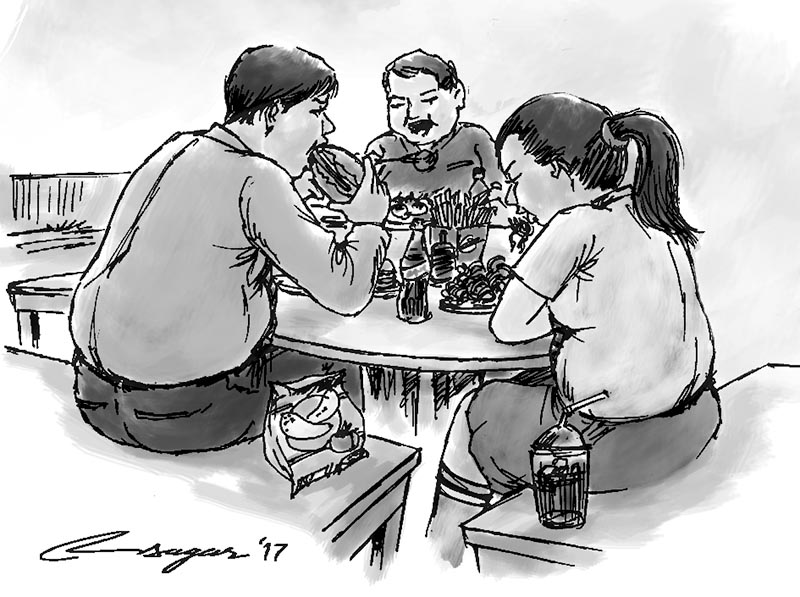We are what we eat: Healthy food
Because of high calorie and low physical exercise, the younger generation is getting fatter. Obesity is increasing day by day, not only in the developed countries but also in the developing countries
In the span of less than five decades, we have witnessed a great change in the food habit of Nepalese people. Processed foods are already the part of life not only in the cities and towns but also in the villages. Instant noodles, biscuits, cheese balls, potato chips and many more are the favorites of many children. Carbonated beverages have already traveled a long distance to the remote areas. The young generation, living in the cities or villages; mountains, hills or Tarai; are fond of eating spicy, sweet, sour and salty foods.
This is not only due to the preference of their taste buds but also due to the ignorance of parents on the nutritional benefits of these snacks. Candies, toffies, spicy and salty tidbits are the normal giveaways by the guests visiting friends and relatives. When the parents from a village visit the local hatbazar or local market center, these snack foods are the preferred treats for the kids. The adverts in the radio and television channels also trigger the children’s perception towards processed foods.
They are easy for parents and tasty for the kids. Even for school tiffin, these are the most preferred snacks. They are very easy to buy, carry and eat. These foods are a boon for busy parents, who have very less time for food preparation for their children.
The meaning of the term ‘junk’ itself gives an idea of junk food. The general meaning of junk is something which is not useful but has a bit large volume. Examples could be used tin cans, used jerry cans, other scraps of household equipment. These junks only fill spaces but have no value at all. This is equally true for junk foods. The junk food can be defined as the food which can fill the stomach, have volume, high in sugar or salt but none or very less amount of nutrients like protein, vitamins, minerals and dietary fibers. Yes, it’s very true that the junk foods have a very high implication in the health of children and youths. But it’s equally important that in the name of junk food, we shouldn’t blame all the foods in the market.
Then, what are the junk ones. By definition, the foods with high sweetness, salt and less nutrients are just junk foods. Sweets, toffies and candies; carbonated sweetened beverages such as soft drinks; salty snacks like chips, cheese balls and other salty snacks like kurkure, kurmure can be considered as junks.
What about the instant noodles and biscuits? What about the juices in tetra packs? These are also taken as junk foods. Are they really junks? According to the definition, these foods have other nutrients like protein in case of noodles and vitamins and minerals in case of juices. If prepared well, along with other nutritious foods such as greens, eggs, peas, onions and tomatoes, noodles are good for health.
These foods do not add up much calorie in our diet. If we can have healthy noodles for dinner, we will have a healthy weight. Even biscuits, taken with other foods such as fruits, vegetables, dairy products are good snacks. Biscuits have protein, vitamins and minerals, and sometimes they are fortified with vitamins and minerals along with high fiber ingredients. Ready to drink fruit juices are also made from the fruit content and have certain amount of vitamins and minerals.Because of high calorie and low physical exercise, the younger generation is getting fatter. Obesity is increasing day by day, not only in the developed countries but also in the developing countries. The habit of consuming high calorie but less nutrient dense diets makes this generation fatter.
The food with high salt, low calorie, less protein and less micronutrients makes them thin and weak as well as deficient in various micronutrients. If one eats only junk foods, takes soft drinks in place of water, snacks on chips and crisp every day, it’s a high risk for those people. If it’s an addiction to the junk foods, then it’s a risk.
Normally, we have the tendency of blaming junk foods. But, it’s very important to try creatively on the healthy options. We have flavored milk in the market, which could be a very healthy option for carbonated soft drinks. Yoghurt and whey drinks can also provide an option. Now, the soft drink companies have started selling drinks with fruit content, which is better than these soft drinks. In the supermarkets, we seek coconut water packed in a tetra pack. We can have our own coconut water packed. If we pack different colored fruits they can be a better option for sweetened fruit drinks. There are healthy snacks like Dalmoth with a mix of different legumes, these can be a good option of crisps and chips, cheese balls and others. In place of sugar candies, the fruit candies made of different fruits can be healthier options. We can work together with the existing companies for healthier products.
We can involve our children in healthy cooking. They are curious in learning new things. Why not work together and try healthy recipes everyday instead of just giving a packet of instant noodle or crisps or chips and letting them end up in sofa and watch cartoon of their choice. It’s the responsibility of parents to develop a good food habit in our children. We can try very many recipes using millet, maize, buckwheat, soybean and different legumes. We can add more fruits and vegetables in the recipes and menus.
Wasti is senior food research officer, Department of Food Technology and Quality Control






